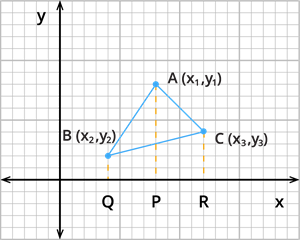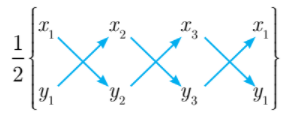UPSKILL MATH PLUS
Learn Mathematics through our AI based learning portal with the support of our Academic Experts!
Learn moreConsider a triangle \(ABC\) whose vertices are \(A (x_1, y_1)\), \(B (x_2, y_2)\) and \(C (x_3, y_3)\).
Draw the perpendiculars \(AP\), \(BQ\) and \(CR\) from \(A\), \(B\) and \(C\) respectively to the \(x -\) axis.
 |
From the figure, it is clear that \(ABQP\), \(APRC\) and \(BQRC\) are all trapezoids.
Therefore, we have:
Area of \(\Delta ABC\) \(=\) Area of trapezium \(ABQP\) \(+\) Area of trapezium \(APRC\) \(–\) Area of trapezium \(BQRC\).
We know that the area of a trapezium is given by:
Area of a trapezium \(=\) \(\frac{1}{2} \times \text{sum of parallel sides} \times \text{distance between the parallel sides}\)
Therefore, Area of \(\Delta ABC = \frac{1}{2}(BQ + AP) QP + \frac{1}{2}(AP + CR) PR – \frac{1}{2}(BQ + CR) QR\)
Rewrite the above equation in terms of coordinates as follows:
Area of \(\Delta ABC\) \(=\) \(\frac{1}{2}\left(y_2 + y_1\right)\left(x_1 - x_2\right)\) \(+\) \(\frac{1}{2}\left(y_1 + y_3\right)\left(x_3 - x_1\right)\) \(-\) \(\frac{1}{2}\left(y_2 + y_3\right)\left(x_3 - x_2\right)\)
Factor out the common terms and rearrange the terms.
Thus, we have:
Area of \(\Delta ABC\) \(=\) \(\frac{1}{2}\left[x_1 \left(y_2 - y_3\right) + x_2 \left(y_3 - y_1\right) + x_3 \left(y_1 - y_2\right)\right]\) square units.
Another form of the formula:
The above given formula can also be written as follows:
Area of \(\Delta ABC\) \(=\) \(\frac{1}{2}\left[ \left(x_1y_2 + x_2y_3 + x_3y_1\right) - \left(x_2y_1 + x_3y_2 + x_1y_3\right)\right]\) square units.
The above formula can be easily remembered using the following pictorial representation.
 |
Example:
Find the area of the triangle joining the vertices \((- 2, 1)\), \((- 11, -9)\) and \((6, 7)\).
Solution:
By the formula, we have:
Area of the triangle \(=\) \(\frac{1}{2}\left[x_1 \left(y_2 - y_3\right) + x_2 \left(y_3 - y_1\right) + x_3 \left(y_1 - y_2\right)\right]\) square units
Substitute the required values in the above formula.
Area of the triangle \(=\) \(\frac{1}{2}\left[- 2 \left(-9 - 7\right) + (- 11) \left(7 - 1\right) + 6 \left(1 - (-9)\right)\right]\)
\(=\) \(\frac{1}{2}\left[- 2 \left(-16\right) + (- 11) \left(6\right) + 6 \left(10\right)\right]\)
\(=\) \(\frac{1}{2}\left[32 - 66 + 60 \right]\)
\(=\) \(\frac{26}{2}\)
\(=\) \(13\)
Therefore, area of the triangle joining the vertices \((2, 1)\), \((11, -9)\) and \((6, 7)\) is \(13\) square units.
Important!
To calculate the area of a polygon, divide it into triangular regions, which have no common area, and add the areas of these regions.